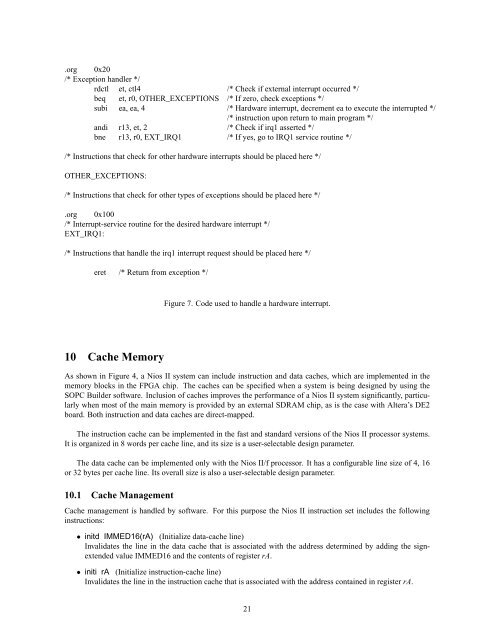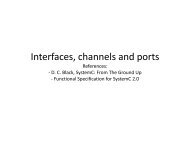Introduction to the Altera Nios II Soft Processor - FTP - Altera
Introduction to the Altera Nios II Soft Processor - FTP - Altera
Introduction to the Altera Nios II Soft Processor - FTP - Altera
You also want an ePaper? Increase the reach of your titles
YUMPU automatically turns print PDFs into web optimized ePapers that Google loves.
.org 0x20<br />
/* Exception handler */<br />
rdctl et, ctl4 /* Check if external interrupt occurred */<br />
beq et, r0, OTHER_EXCEPTIONS /* If zero, check exceptions */<br />
subi ea, ea, 4 /* Hardware interrupt, decrement ea <strong>to</strong> execute <strong>the</strong> interrupted */<br />
/* instruction upon return <strong>to</strong> main program */<br />
andi r13, et, 2 /* Check if irq1 asserted */<br />
bne r13, r0, EXT_IRQ1 /* If yes, go <strong>to</strong> IRQ1 service routine */<br />
/* Instructions that check for o<strong>the</strong>r hardware interrupts should be placed here */<br />
OTHER_EXCEPTIONS:<br />
/* Instructions that check for o<strong>the</strong>r types of exceptions should be placed here */<br />
.org 0x100<br />
/* Interrupt-service routine for <strong>the</strong> desired hardware interrupt */<br />
EXT_IRQ1:<br />
/* Instructions that handle <strong>the</strong> irq1 interrupt request should be placed here */<br />
eret /* Return from exception */<br />
Figure 7. Code used <strong>to</strong> handle a hardware interrupt.<br />
10 Cache Memory<br />
As shown in Figure 4, a <strong>Nios</strong> <strong>II</strong> system can include instruction and data caches, which are implemented in <strong>the</strong><br />
memory blocks in <strong>the</strong> FPGA chip. The caches can be specified when a system is being designed by using <strong>the</strong><br />
SOPC Builder software. Inclusion of caches improves <strong>the</strong> performance of a <strong>Nios</strong> <strong>II</strong> system significantly, particularly<br />
when most of <strong>the</strong> main memory is provided by an external SDRAM chip, as is <strong>the</strong> case with <strong>Altera</strong>’s DE2<br />
board. Both instruction and data caches are direct-mapped.<br />
The instruction cache can be implemented in <strong>the</strong> fast and standard versions of <strong>the</strong> <strong>Nios</strong> <strong>II</strong> processor systems.<br />
It is organized in 8 words per cache line, and its size is a user-selectable design parameter.<br />
The data cache can be implemented only with <strong>the</strong> <strong>Nios</strong> <strong>II</strong>/f processor. It has a configurable line size of 4, 16<br />
or 32 bytes per cache line. Its overall size is also a user-selectable design parameter.<br />
10.1 Cache Management<br />
Cache management is handled by software. For this purpose <strong>the</strong> <strong>Nios</strong> <strong>II</strong> instruction set includes <strong>the</strong> following<br />
instructions:<br />
• initd IMMED16(rA) (Initialize data-cache line)<br />
Invalidates <strong>the</strong> line in <strong>the</strong> data cache that is associated with <strong>the</strong> address determined by adding <strong>the</strong> signextended<br />
value IMMED16 and <strong>the</strong> contents of register rA.<br />
• initi rA (Initialize instruction-cache line)<br />
Invalidates <strong>the</strong> line in <strong>the</strong> instruction cache that is associated with <strong>the</strong> address contained in register rA.<br />
21

















